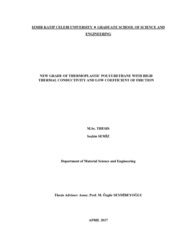New grade of thermoplastic polyurethane with high thermal conductivity and low coefficient of friction
-
Eser Sahibi
Semiz, Seçkin
- Tez Danışmanı M. Özgür SEYDİBEYOĞLU
-
Tür
Yüksek Lisans
- Yayın Tarihi 2017
-
Yayıncı
İzmir Katip Çelebi Üniversitesi Fen Bilimleri Enstitüsü
- Tek Biçim Adres Http://hdl.handle.net/11469/315
Today, thermoplastic polyurethane materials are widely used in many different
applications. There are many types of thermoplastic polyurethanes which offers
different mechanical and chemical properties according to application area. In
addition to the existing properties, thermoplastic polyurethane materials mixed with
various additives to obtain specific, targeted thermoplastic polyurethane materials in
order to impart different properties to the material for application.
In this study, materials of the sealing elements are approached which is one of the
most important parts of the hydraulic & pneumatic systems widely used in industry.
Nowadays when energy efficiency and product life become vital, it is quite important
that prolongation of the sealing element life, increasing the energy efficiency and
reducing maintenance requirements for hydraulic & pneumatic sealing elements
sector. This study gains importance in terms of bringing the properties such as low
coefficient of friction and high thermal conductivity coefficient in materials of
hydraulic pneumatic sealing materials without breaking the standard physical and
chemical properties of the material.
Standard features expected from hydraulic & pneumatic sealing materials
summarized as tensile strength, elongation at break, hardness, deformation under
pressure (compression set) and wear resistance. In addition to these properties of
standard materials, it envisaged that imparting low coefficient of friction to materials
will reduce wearing because of friction and heat formation, imparting high thermal
conductivity will facilitate transferring the heat generated from the material to the
surrounding area. If these two properties are insufficient, burn spots and abrasions
due to temperature increase observed in the working surfaces of the sealing elements.
Herewith these problems cause leakage that is the indication of failure. By
preventing these situations, the sealing elements will be able to benefit from the
sector with higher energy efficiency and longer working life.
Four different additive materials such as boron nitride, MoS2 ,graphite and PTFE
were used at three different doses each to gain the specified properties to the
thermoplastic material which is used in this study. The base material compounded
with the additives was re-granulated with twin-screw extruder and after heat
treatment of the materials, test plaques and sealing elements were produced with the
help of plastic injection machines.
xxvi
FTIR, thermal conductivity coefficient, tensile, compression set, coefficient of
friction and friction tests carried out to examine the properties expected to change.
When all the results analyzed according to the tests performed, it has been observing
that Sample 6 which has 5% PTFE acquired the targeted properties without
deteriorating the existing properties. In this compounded material, the coefficient of
thermal conductivity increases and the coefficient of friction decreases while the
hardness, stress at 100% strain and compression set values are within acceptable
limits.
-
Koleksiyonlar
ENSTİTÜLER
FEN BİLİMLERİ ENSTİTÜSÜ

 Tam Metin
Tam Metin

